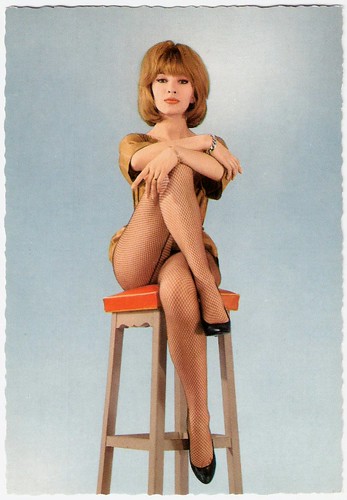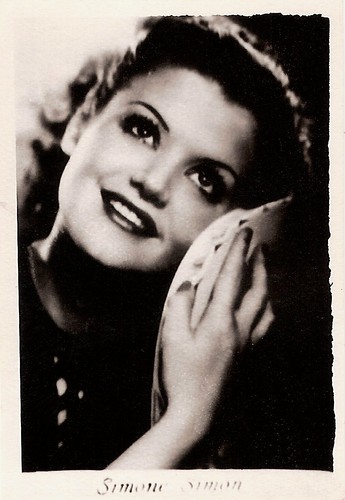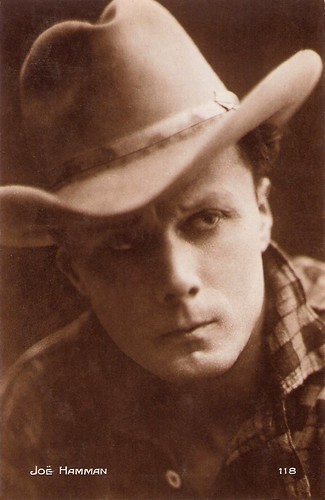British-Austrian actress Mara Lane (1930) was considered one of the most beautiful models in Great Britain during the early 1950’s. She appeared in more than 30 English and German language films of the 1950’s and early 1960’s, but seems completely forgotten now.
Dany Saval
Dany SavalGorgeous French actress Dany Saval (1942) was the lithe and lovely leading lady in both fluffy comedies and thrillers of the late 1950’s and early 1960’s.
Dany Saval was born as Danielle Nadine Suzanne Savalle in 1942 in in a slum area of Paris, France. The Germans had just before released her father, a factory worker, from a prisoner-of-war camp. Dany started her career at 8, as a child-dancer. Later she became a Can-Can girl at the Moulin Rouge. Her first film appearance was a small part in L'eau vive/The Girl and the River (1958, François Villiers) starring Pascale Audret. The film, based on a screenplay by pacifist writer Jean Giono, won a Golden Globe as Best Foreign-Language Film in 1959. She then appeared in the French answer to Rebel Without A Cause, Les Tricheurs/The Cheaters (1958, Marcel Carné), as the fiancée of Pierre Brice. Les Tricheurs tells the story of disaffected Parisian youth who have lost their way in an atmosphere of existentialism, sexual liberation and disrespect for traditional and religious values. On the huge success of Les Tricheurs followed bigger roles in such films as Asphalte/Asphalt (1959, Hervé Bromberger) with Francoise Arnoul, La verte moisson/Green Harvest (1959, François Villiers) and the supernatural thriller Pleins feux sur l'assassin/Spotlight on a Murderer (1961, Georges Franju) starring Pierre Brasseur.
Suddenly one of Disney’s talent scouts saw Dany Saval on a magazine cover and after a screentest Walt Disney signed her to a six-film contract. In her first film, Moon Pilot (1962, James Neilson), she played a mysterious extraterrestrial opposite astronaut Tom Tryon. Hal Erickson of All Movie Guide likes the film: “Moon Pilot is an engaging Disney sci-fi comedy that manages to shoot off a few neat and surprisingly satirical barbs at the hypertense US/Russia ‘space race’ of the era.” On IMDB, reviewer San Diego comments: “Watch it for Dany Saval... (she) makes the film worth watching.” Despite these positive reviews, the film bombed and Dany Saval would make only one more American film. Today she is probably best known as one of the lovely airline stewardesses being shuffled around by Tony Curtis and Jerry Lewis in the slapstick comedy Boeing Boeing (1965, John Rich). IMDB reviewer Moonspinner55 writes: “Perky Dany Saval (as ‘Air France’) is the stand-out amongst the lovely ladies, none of whom gets an actual character to play.” In between she appeared in several fluffy French comedies opposite such comedians as Louis de Funès and Darry Cowl. She also appeared opposite Michele Morgan in the crime thriller Constance Aux Enfers/Web of Fear (1964, François Villiers). In 1965 she married distinguished composer Maurice Jarre, with whom she had a daughter, Stéfanie Jarre. She then retired temporarily from the screen to raise her child.
In 1970, Dany Saval made a come-back on TV in the popular comedy series Les saintes chéries/The Sweet Saints starring Micheline Presle. More TV work and films followed. She was the leading lady in the spaghetti western Si può fare... amigo/Saddle Tramps (1972, Maurizio Lucidi) starring Bud Spencer and Jack Palance. In the popular action comedy L’Animal/The Animal (1977, Claude Zidi), she appeared opposite Jean-Paul Belmondo and Raquel Welch. And she played a supporting part in the detective comedy Inspecteur la Bavure/Inspector Blunder (1980, Claude Zidi) starring Coluche and Gérard Dépardieu. Her last (TV) film was La baleine blanche/Children and the White Whale (1987, Jean Kerchbron). Then, Dany Saval retired from the film and entertainment business. She married three times. Her first marriage was with pr-man Roger Chaland in 1958. Her second marriage with Maurice Jarre ended in a divorce in 1967. Since 1973, she is married to host and journalist Michel Drucker, with whom she resides in Paris.
Sources: Lloyd Shearer (The Modesto Bee), Hal Erickson (All Movie Guide), Wikipedia, and IMDb.
Lil Dagover was actress whose career spanned nearly six decades
Lil DagoverGallery for vintage actress Lil Dagover
Dolly Haas was popular in the 1930s as a vivacious red haired gamine
Dolly HaasStage and screen actress Dolly Haas (1910-1994) was popular in the 1930’s as a vivacious, red-haired gamine often wearing trousers in German and British films.
Gallery for vintage actress Dolly Haas
Annabella
AnnabellaFrench film star Annabella (1909-1996) was France's most popular actress during the mid 1930’s, but she also achieved some success in Hollywood films of the late 1930’s.
Simone Simon
Simone SimonKittenish French actress Simone Simon (1910-2005) was one of the most seductive and brilliant stars of the French cinema of the 1930’s and 1950’s. Publicity dubbed her ‘La Sauvage Tendre’ (The Tender Savage).
Charles de Rochefort
Charles de RochefortCharles d’Authier de Rochefort (1887-1952) was born in Port-Vendres, France. In 1910 he started to play in film, most of all in the Pathé comedies of Max Linder (8 films between 1910 and 1914), but also in Pathé dramas by Georges Denola, Albert Capellani and Abel Gance. In 1918 he performed in the serial Impéria (12 episodes) by Jacques Durand, with Jacqueline Forzane. After the films Marthe (Gaston Roudès 1919), Fille du peuple (Camille de Morlhon 1920), L’empire du diamant (Léonce Perret 1920) and Roi de Camargue (André Hugon 1921) – for which film this postcard might have been – De Rochefort again appeared in two serial films: Gigolette (Henri Pouctal 1921, 4 episodes) and L’empereur des pauvres (René Leprince 1921, 6 episodes). In 1922 Rochefort played in several films: in Antoine’s L’Arlésienne, two films by Hugon: Notre dame d’amour and Le diamant noir, L’homme qui pleure by Louis d’Hée, and the co-production The Spanish Jade/Sous le soleil d’Espagne by John S. Robertson and starring Evelyn Brent. After two more French films in 1923: La dame au ruban de velours (Giuseppe Guarino) with Arlette Marchal, and La faute des autres (Jacques Olivier) with Mary Thay, Charles de Rochefort went to Hollywood.
There, in 1923, he played in The Marriage Maker by William C. DeMille, with Mary Astor; he briefly appeared in Holywood/Joligud by James Cruze; he also played in The Cheat by George Fitzmaurice, with Pola Negri; The Law of the Lawless by Victor Fleming, with Dorothy Dalton; and The Ten Commandments by Cecil B. DeMille, with Rod La Rocque. In the subsequent year 1924 followed 4 more American films: Love and Glory by Rupert Julian; Shadows of Paris by Herbrt Brenon; The White Moth by Maurice Tourneur; and Madame Sans-Gêne by Léonce Perret, a super-production around Gloria Swanson. In 1925 Roochefort left Hollywood and returned to France, where he played in one film: La princesse aux clowns (Hugon) with Huguette Duflos. Rochefort then stayed away from film for four years. When he returned in 1929 it was not as actor but as director at the Parisian Paramount sound studios, first with Une femme a menti (1929) with Louise Lagrange and scripted by Henri Koster [Hermann Kosterlitz], then in 1930 with the French, Italian, Czech and Rumanian version of Paramount on Parade, starring resp. Maurice Chevalier, Carmen Boni, Jiri Voskovec and Pola Illéry. Rochefort also directed the mulitilingual Le secret du docteur (1930), with Marcelle Chantal in the French and Eugenia Zoffoli in the Spanish version. In 1931 Rochefort acted once more in the film La croix du sud (Hugon), for which he also did the photography, and he directed Televisione, the Italian version of the Paramount multilingual Television. He also directed the short Dorville chauffeur (1930) and Un bouquet de flirts (1931) with Josette Day. Charles de Rochefort died in Paris in 1952.




























